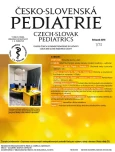Possibilities of antibiotic treatment of acute otitis media
Authors:
I. Šlapák
Authors‘ workplace:
Klinika dětské ORL LF MU a FN Brno
Published in:
Čes-slov Pediat 2018; 73 (7): 459-462.
Category:
Review
Overview
Acute Otitis Media Acute (OMA) is one of the most common inflammations in childhood. The causes of acute inflammation of the middle ear include: Eustachian tube dysfunction and insufficient immune protection. In the clinical picture of acute middle ear inflammation, ear pain and hearing impairment prevail. The most common agent is the initial phases of viruses and bacterial superinfection involves the most common Streptococcus pneumoniae, Haemophillus influenensae, Moraxella catharhalis.
Generally, fever and agitation are present. Diagnosis of middle ear inflammation is based on otological examination based on otoscopy. Paracenthesis, antipyretic and analgesic (ibuprofen, paracetamol) are used during treatment. Antibiotics are indicated for acute mild inflammation in cases of advanced inflammation, in case of suspected complications of inflammation and in children under one year of age.
Recent studies with recent years compare the effect of cefprozil and potent amoxicillin in the treatment of acute middle ear inflammation. Both antibiotics administered showed the same antibacterial effect and comparable outcome in the course and outcome of treatment. However, Cefrozil showed statistically significantly fewer side effects than potentiated amoxicillin. It has been most commonly found that cefprozil does not occur as often as gastrointestinal symptoms (flatulence, diarrhea, abdominal pain) as with potent amoxicillin. Thus, Cefprozil becomes an advantageous option in the treatment of acute middle ear inflammation, particularly in cases where the patient is allergic to the penicillin family. It offers less side effects and better tolerance when used in pediatric patients.
Key words:
acute otitis media, otoscopy, paracethesis, antibiotics
Sources
1. Bolaños-Díaz R, Calderón-Cahua M. Cefprozil versus Amoxicillin/Clavulanate for the treatment of Acute Otitis Media in children: Meta-analysis of efficacy and safety. Pharmacology & Pharmacy 2014; 5 (4): 386-394. doi 10.4236/pp.2014.54046.
2. Hedrick JA, Sher LD, Schwartz RH, Pierce P. Cefprozil versus high-dose Amoxicillin Klavulanate in children with Acute Otitis Media. Clin Therapeutics 2001; 23 (2).
3. Šlapák I., Horník P. Akutní zánět středouší v dětském věku. Brno: Signet, 1995. ISBN 80-900605-2-8.
4. Šlapák I. Doporučený postup: „Bolest ucha“. Praha: ČLS JEP, 2001.
5. Klačanský J, Jakubíková J. Detská otolaryngológia. Martin: Osveta, 1992.
6. Froom J, Culpepper L, Jacobs M, et al. Antimicrobials for acute otitis media? A review from the International Primary Care Network. BMJ 1997; 315: 98–102.
7. Myrbakk T, Gićver A, Olsvik Ř, Flćgstad T. Antibiotic treatment of acute otitis media in children. Tidsskr Nor Lćgeforen 1999; 119: 2649–2652.
8. Williams RL, Chalmers TC, Stange KC, et al. Use of antibiotics in preventing recurrent acute otitis media and in treating otitis media with effusion: A meta-analytic attempt to resolve the brouhaha. JAMA 1993; 270: 1344–1351.
9. Casslbrant ML, Kaleida PH,Rockette HE, et al. Efficacy of antimicrobial prophylaxis and of tympanostomy tube insertion for prevention of recurrent acute otitis media: results of a randomised clinical trial. Paediat Infect Dis J 1992; 11: 278–286.
Labels
Neonatology Paediatrics General practitioner for children and adolescentsArticle was published in
Czech-Slovak Pediatrics

2018 Issue 7
Most read in this issue
- Possibilities of antibiotic treatment of acute otitis media
- Tubulointerstitial nephritis as a cause of acute renal insufficiency in children
- Hearing loss and hearing impairment in chidhood
- History and present of cochlear implantations in Czechia
